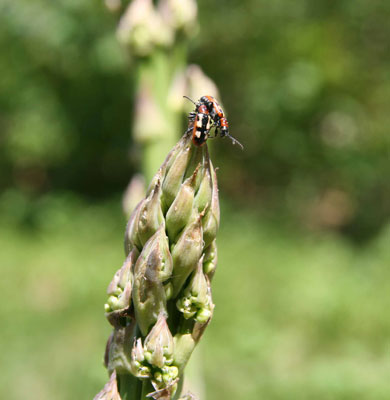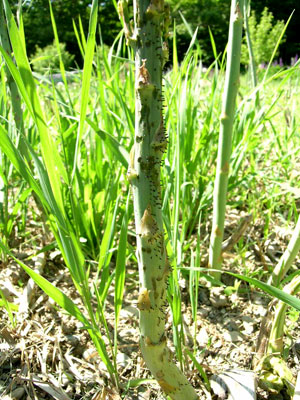
Pest: Asparagus Beetle, Common (Crioceris asparigi) and Spotted (Crioceris duodecimpunctata)
Pest identification and lifecycle, most common symptoms and crops affected:
Common Asparagus Beetle (Crioceris asparigi)
Blue-black, shiny, smooth and about 6 to 9 millimeters (1/4 inch) long, with three large yellow, squarish spots with red margins along each wing cover. Eggs are black, laid standing on end in rows along the spears, and hatch in 3-8 days. Larvae are wrinkled, plump, hump-backed and dull gray with black head and legs. Some people call them “worms.” They grow up to 1/3 inch.
The larvae feed in asparagus spears and in ferns. The larvae do the most damage, and eggs and larval damage makes spears unmarketable. Larval feeding can cause severe defoliation and weaken the stand.

When full grown, larvae drop to the soil and pupate underground. New adults emerge in July, feed in ferns, and by September are looking for overwintering sites. Both species spend the winter as adult beetles either in field borders or within the asparagus field. Sheltered sites such as under bark or in the stems of old plants are preferred. Some burrow into the soil.

Spotted Asparagus Beetle (Crioceris duodecimpunctata)
Reddish orange or tan, with six black spots on each wing cover (hence its other name, 12-spotted asparagus beetle). Eggs are greenish, glued singly on their sides to leaves. Eggs are laid on fronds, not on spears. Larvae are similar to those described above, but are orange-colored.
They feed almost entirely inside the asparagus berries so they affect seed production but do not hurt the plants.
The Spotted Asparagus Beetle usually becomes active later in the spring than the Common Asparagus Beetle, and is less common. These beetles are closely related and share a similar lifecycle.
Management options:
Cultural:
During harvest, you can greatly reduce the population by harvesting all of the ready spears every harvest. Do not allow any spears to develop into fronds until you are all done harvesting for the season. This reduces the number of stems where eggs will survive, and larvae can feed and grow up into the summer-generation beetles.
In the fall remove all of the crop residue and other refuse nearby that provides shelter for adults over winter. Maintaining a clean environment in the fall will force beetles to seek shelter outside the field or burrow in the soil, where many predators reside.
One grower reported success with a homemade trap: a wooden dowel shaped and painted green to resemble an asparagus spear, that is then coated with Tanglefoot, or similar, and placed in the garden as a decoy.
Biocontrol options:
The most important natural enemy of common asparagus beetle is a tiny parasitic wasp (Tetrastichus asparagi) that attacks the egg stage. Wasps kill eggs by feeding on them (sucking them dry) and also lay their own eggs inside the beetle eggs. The immature wasps grow inside the beetle larvae, killing them when they pupate. Studies have found greater than 50% of eggs killed by feeding and half of the surviving larvae parasitized. Providing a nearby nectar source such as umbelliferous flowers may enhance wasp populations.
Pesticides approved for use in certified organic production (as a last resort):
Scout fields regularly. You may want to treat spears if greater than 10% of the plants are infested with beetles. The daily harvest makes treatment difficult because few want to spray anything close to harvest time. Treating infested fronds is important. Organic options include Entrust (Monterey Garden Spray for gardeners). Surround WP may work as a repellent.
Please note: This information is for educational purposes. Any reference to commercial products, trade or brand names is for information only, and no endorsement or approval is intended. Pesticide registration status, approval for use in organic production and other aspects of labeling may change after the date of this writing. It is always best practice to check on a pesticide’s registration status with your state’s board of pesticide control, and for certified organic commercial producers to update their certification specialist if they are planning to use a material that is not already listed on their organic system plan. The use of any pesticide material, even those approved for use in organic production, carries risk — be sure to read and follow all label instructions. The label is the law. Pesticides labeled for home garden use are often not allowed for use in commercial production unless stated as such on the label.
Source material attribution: Informed by: Eric Sideman. Thanks to: Ruth Hazzard (UMass Vegetable Notes and The New England Vegetable Management Guide) and Brian Caldwell, Cornell University.
